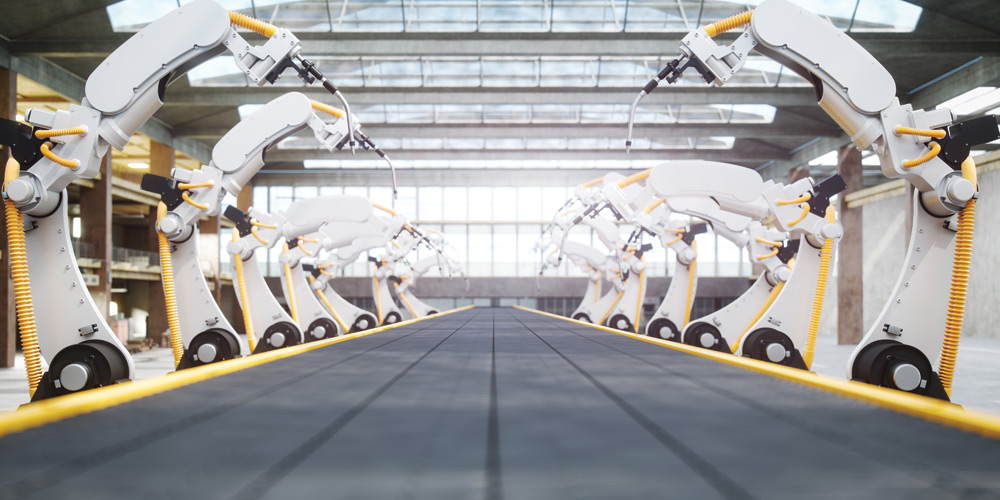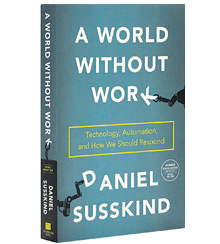A brave new workless world
In his new book, Oxford University economist Daniel Susskind sketches out the perils and promise of automation’s displacement of labor.
A World without Work: Technology, Automation,
and How We Should Respond
by Daniel Susskind, Henry Holt, 2020
How would you feel if you no longer had to work? Ecstatic? Empty? Relieved? Anxious? All of the above? Economists and other thinkers have long debated the function of work in shaping human identity. Sigmund Freud considered work “indispensable,” and Adam Smith thought it “toil and trouble.”
Daniel Susskind, an Oxford professor and former government advisor, believes that work “is so entrenched in our psyches that there is often an instructive resistance to contemplating a world with less of it, and an inability to articulate anything substantial when we actually do.” His argument in A World without Work, a useful and farsighted book on the subject, is threefold: that within our lifetime, automation will result in insufficient work to go around; that this structural technological unemployment, if ignored, would make our already unfair world vastly more unequal; and that to prevent this outcome, governments’ approach to labor policy needs to be entirely rethought.
Of these three strands, Susskind’s first is his most convincing. To be sure, he acknowledges, workers have regularly panicked unnecessarily about being replaced by machines. But this time, he argues, the threat is real. His best evidence of the frightening pace at which AI is developing comes through attempts to build robots to play chess and Go. For years, scientists followed an approach of trying to copy human thought and behavior. This proved impossible to replicate, and by the late 1980s, AI appeared to have hit a wall.
Then, in 1997, IBM’s Deep Blue beat grandmaster Garry Kasparov at chess. It was a milestone because the machine did not think like Kasparov. Instead, it used what Susskind calls “brute-force processing power” to calculate more moves further ahead than its human opponent. In 2016, a robot called AlphaGo beat Lee Sedol, the best human player in the world, at Go, in part by making a move that went against perceived human wisdom. A year later, the next-generation program AlphaGo Zero was given nothing more than the rules of the game. After three days of playing millions of games against itself, it demolished the original AlphaGo. In just a few years, this pragmatic approach enabled machines to compete with humans, defeat the best of them, and then supplant them entirely.
Susskind provides a wealth of supporting claims for the idea that automation will render people redundant. Already, machines can generate in three minutes documents that it takes a skilled financial lawyer three hours to produce. Algorithms can write original music so pleasing to classical music aficionados that it is nearly indistinguishable from Bach. The only possible end point, Susskind argues, is structural technological unemployment, whereby machines are sufficiently better than humans at so many tasks that it is impossible to employ many (or most) members of the workforce. This process, he acknowledges, will take place at different speeds, depending on the composition of economies and the products and services they produce.
For a sneak peek at that future, Susskind cites the U.K.’s agriculture sector. Over the past 150 years, technology has pushed up agricultural output almost fivefold, but the number of people employed has fallen. He notes that greater efficiencies create new demand, but that eventually this will generate more work for machines, not humans. A startling study of industrial robots in the U.S. a decade ago found that the introduction of one new robot per 1,000 workers cut 5.6 jobs from the economy and suppressed wages.
Susskind warns that a world without work will also be a vastly more unequal one. As the tasks many workers perform become automated, they will see the value of their human capital fall to zero. Meanwhile, the value of capital income, or the profits created through the work done by robots, will flow to the stockholders of a small number of parent companies. The automation industry is suited to a small number of large players, not a large number of small ones. Pioneering AI requires huge amounts of data and processing power, and startups are quickly snapped up by giants. Alphabet, Amazon, Apple, Facebook, and Microsoft spent US$131 billion on 435 acquisitions in the 10 years leading up to mid-2017.
The automation industry is suited to a small number of large players, not a large number of small ones. Pioneering AI requires huge amounts of data and processing power, and startups are quickly snapped up by giants.
How, then, to hold together a society where few are capable of providing for themselves and all of the wealth is owned by a small coterie? The answer may lie in a bigger role for the government, one focused not on the production of wealth, but on its distribution. Market forces have not shared wealth equitably; Susskind reminds us that the previous two major declines in inequality were driven by the Black Death of the 14th century and the two world wars of the 20th century. And ramping up existing welfare state measures wouldn’t do the trick, as these are intended to nudge recipients back to work.
Instead, he calls for a redesigned set of labor laws that push up taxes for those who manage to retain the value of their capital and distribute that revenue among the rest. And to make sure distribution is equitable, Susskind advocates for a modified universal basic income, but one with some societal contribution necessary to receive payments. He is honest enough to say he finds it hard to know exactly what that might be, but believes that pursuing “artistic and cultural ends,” “political activities,” and “educational, household, and caring activities” are all possibilities.
The government would have other functions in his Big State, such as investing surplus revenue in funds, crafting legislation to help ease the transition toward work scarcity (such as by reducing hours and boosting wages), and adopting more constructive leisure policies.
Inevitably, Susskind’s gaze into the future is a little fuzzy. His hypothetical, fully automated economy seems insular and closed. He does not consider some of the era-defining macroeconomic trends likely to unfold in parallel, such as the dramatic shrinkage of the working-age populations in much of North America, Europe, and Asia, combined with surges in some big emerging markets, such as Nigeria. Prevailing attitudes regarding immigration and the cost of imported labor will be major determining factors in the rate of automation’s adoption. But Susskind is right that work is such a fundamental part of modern identity that it is hard to conceive of a world without it, and his is an admirable attempt to do so.
Author profile:
- Mike Jakeman is a freelance journalist and has previously worked for PwC and the Economist Intelligence Unit.






